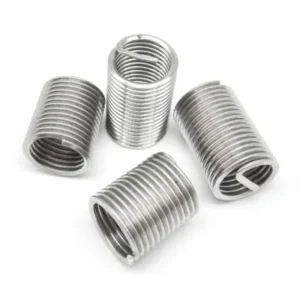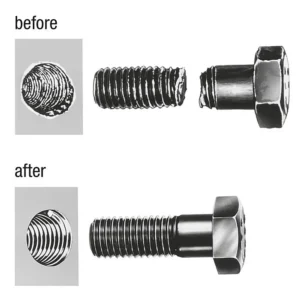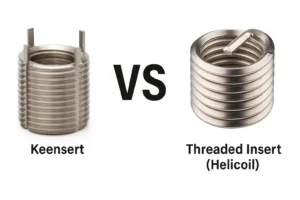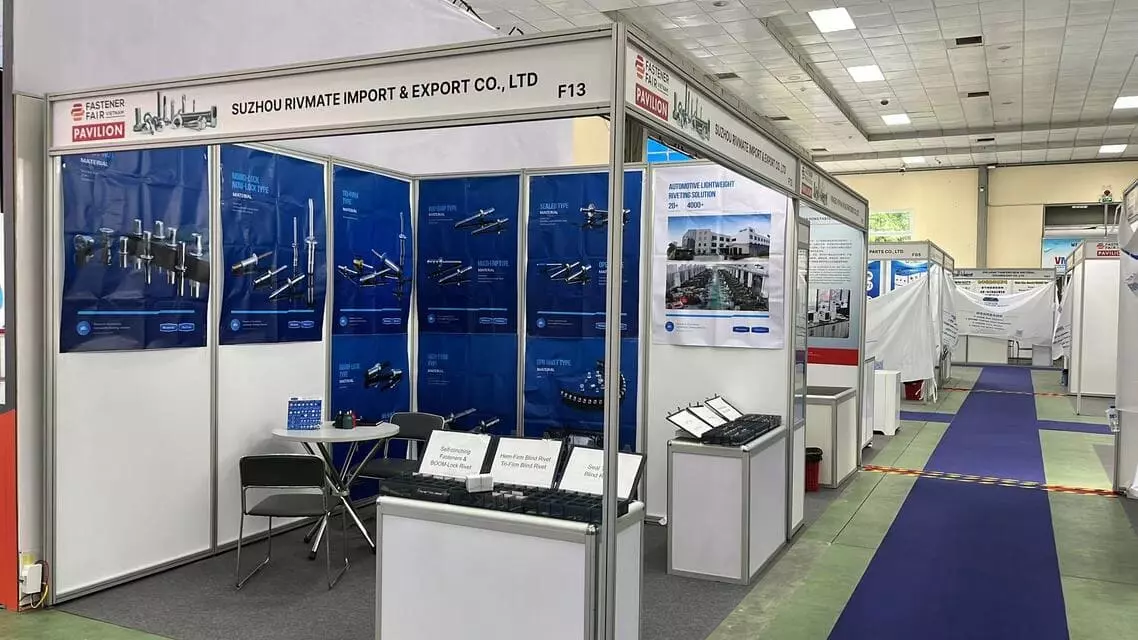What Are Threaded Inserts?

Leading Threaded Inserts Manufacturer and Supplier in China
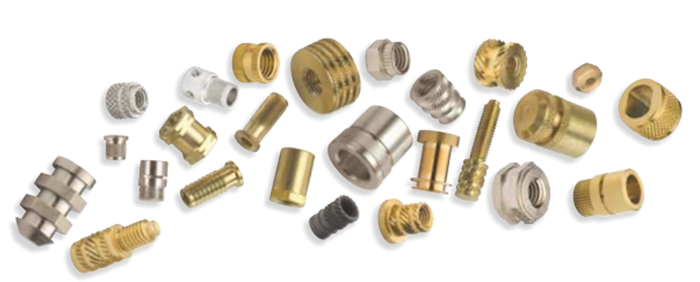
When it comes to creating strong, reliable threads in soft or thin materials—such as plastics, aluminum, or composites—threaded inserts are the go-to solution. But what are threaded inserts, exactly? These small but powerful components are designed to reinforce or repair tapped holes, allowing for repeated assembly and disassembly without degrading the base material. Whether you’re in automotive, aerospace, electronics, or general manufacturing, understanding how to choose the right threaded insert can drastically improve product durability and reduce long-term maintenance costs.
Table of Contents
What Are Threaded Inserts?

Threaded Inserts are small metal or plastic parts pre-threaded with internal threads, designed to be embedded into a base material (e.g., plastic, wood, metal, or composite) to create a strong, reusable, internally-threaded joint on a substrate that cannot be tapped directly or is prone to threading.
It is often used to strengthen the joint area and improve the abrasion resistance and tensile strength of the structure, and is particularly suitable for low strength materials such as plastics, aluminum, and wood.
① Difference from Ordinary Threaded Holes
| Comparison Items | Ordinary Threaded Holes | Threaded Inserts |
|---|---|---|
| Fabrication | Direct Tapping | Inserted into Threaded Structures |
| Applicable Base Materials | Mainly Metal | Metals, Plastics, Wood, etc. are all possible |
| Tensile Strength | Depends on the strength of the base material | Determined by the Insert itself, which is stronger |
| Repeatable | Wearable with multiple installations and removals | For Frequent Removals and Installations |
| Reparability | Threaded | Repairability |
② Differences from Rivet Nuts
| Item | Threaded Inserts | Rivet Nuts |
|---|---|---|
| Mounting Method | Press-in, Hot Insert, Screw-in, etc. | Formed by force applied by riveting tool |
| Applicable Scenarios | Mostly used for non-metallic base materials such as plastics/woods etc. | Mostly used for structures such as sheet metal, thin-walled metals etc. |
| Morphology | Typically cylindrical/threaded housings | With flanges, tails plasticize |
| Disassembly | Can be pulled out and replaced | Generally irreversible removal |
Summary:
Threaded Inserts are an indispensable fastener solution for modern assembly design, enabling high-strength, long-life, removable threaded connections in materials with insufficient structural strength, and are used in a wide range of applications. Including plastic injection molded parts, 3D-printed components, wood furniture, avionics, and many others.
How Do Threaded Inserts Work?

Threaded inserts are embedded into the interior of the base material through a specific mounting pattern to form a stable, pull-out resistant, reusable threaded joint. At its core, the mechanical locking or friction fixing of the base material is achieved by means of a shape structure, external threads or anti-rotation devices, providing high strength threads even in soft materials.
I. Installation principle
Threaded inserts can be adapted to different materials, common installation methods include:
a. Press-In Inserts
Scenarios:
Rigid substrates such as thermoset plastics, soft metals (e.g., aluminum alloys), and 3D printed parts.
Installation Principle:
Press-in threaded inserts are usually designed with a knurled, chamfered or serrated structure on their outer wall and are pressed into pre-drilled holes by applying direct axial pressure. During installation, a high friction and mechanical bite is generated between the outer surface of the insert and the bore wall of the base material, thus preventing the threaded insert from rotating or being pulled out.
Features:
- Fast installation, no need for special heating or screwing tools;
- High tolerance requirements for hole diameter, too loose to loosen, too tight may crack the substrate;
- Suitable for small batch or prototype sample assembly;
- Can be operated with presses or simple press fixtures.
b. Self-Tapping Inserts
Application Scenarios:
Wood, soft plastics, engineering resins, composites, etc.
Installation Principle:
Self-Tapping Inserts have a self-tapping external thread structure (coarse or cutting edge) that can be rotated and “tapped” into the base material without the need for prior thread tapping. The internal thread is used to carry the screw, while the external thread provides mechanical fixation to the base material.
Characteristics:
- Easy to install, hand or power tool operated;
- Ideal for repair, replacement or later addition of threaded features;
- Reusable with some dismantling capability;
- Suitable for products such as furniture, instrument housings, jigs and fixtures.
c. Heat-Set / Ultrasonic Inserts
Applicable Scenarios:
Thermoplastic (e.g. ABS, PP, PC, PBT, PA, etc.) injection molded parts, shell structure.
Installation Principle:
Hot melt inserts installation process through the electric iron heating, or the use of ultrasonic high-frequency vibration, so that the inserts around the plastic ** local melting and softening **, inserts gradually embedded. After cooling, the plastic material will tightly cover the concave-convex structure of the insert, to achieve a solid lock.
Characteristics:
- The common structures of hot melt inserts are straight, threaded, barbed, etc., which enhance the occlusal effect;
- Beautiful surface and stable structure after installation, suitable for appearance parts;
- Batch operation is possible, suitable for automated fixture or insert workstation integration;
- Ultrasonic mounting is suitable for high precision and fast production line applications.
d. Molded-In Inserts
Applicable Scenarios:
Plastic injection molded parts, structural parts, and parts with high connection strength requirements.
Installation Principle:
Before plastic injection molding, the insert is positioned in advance in the mold at a designated location, followed by high-temperature and high-pressure injection molding, the molten plastic will be embedded in the insert package, after cooling and solidification. The inserts are completely encapsulated within the plastic, forming a very high resistance to pull-out and twisting.
Features:
- The strongest mounting method for structural connectors;
- No post-installation process required, suitable for efficient batch injection molding production;
- High requirements on mold design and insert size;
- The mounting position cannot be modified and is not suitable for later maintenance and replacement.
II. Clamping/Locking Mechanisms During Operation
a. External Wall Locking Mechanism
The outer wall of threaded inserts is usually designed with a variety of anti-spin structures, such as:
- Longitudinal Knurled: Mechanical friction locking against the base material bore wall through straight or cross grain, commonly used for press-fit inserts;
- Barbed or Serrated: Provides a unidirectional anti-backsliding effect, particularly suitable for soft plastic or resin-based substrates;
- Hex Body: with hex pre-drilled holes, physical limitations can be realized, greatly improving the resistance to rotation;
- Self-Tapping External Thread: for wood or soft plastics, it can cut itself to form a stable bite on the base material;
- Helical Groove: Enhances the filling bite of molten plastic in hot melt/ultrasonic installations.
The purpose of these outer wall structures is to ensure that the inserts will not rotate or be pulled out of the base material after installation, even if the screws are tightened several times or subjected to vibration shocks, ensuring long-term stability of the connection part.
b. High-Integrity Internal Threads
Inserts are often internally threaded with standardized thread configurations such as ISO Metric (M) or Imperial (UNC/UNF) threads, offering the following advantages:
- Precise dimensions and standardized teeth: ensure a good fit with standard screws or bolts;
- Materials are mostly steel, stainless steel, brass, with good wear resistance and anti-slip ability;
- Can withstand repeated tightening and dismantling, especially suitable for frequent maintenance of equipment or long-term use of the scene;
- Avoid thread wear, breakage and chipping caused by direct tapping of plastics, significantly improving connection reliability and product life.
c. Frictional and Reactive Forces
After the insert is installed, it is subjected to the axial tension and rotational torque of the screws in actual operation. Its stability depends, in addition to structural occlusion, on:
- Normal pressure between the insert and the base material: from the compression or tightening forces during installation;
- This pressure generates a frictional force that prevents the insert from idling along with it as the screw rotates;
- Reverse support force comes from the body of the base material encasing or squeezing the insert and is an important support against pullout;
- In hot melt, in-mold or press-in structures, cooled or press-fit material reaction force, so that the insert is in a “pre-pressurized” state, further enhancing stability.
①. Press-In Inserts
- Materials: Mainly used for plastics, soft metals (e.g. aluminum).
- Structural features: The outer wall is usually knurled, grooved or barbed to enhance the friction and anti-rotation ability of the inserted hole.
- Method of installation: pressed into preformed holes by press, jig or manually without heating or tapping.
- Advantages:
- Simple installation for low-cost applications;
- Less likely to damage the base material;
- Less susceptible to slipping teeth when tightening bolts repeatedly.
- Disadvantages: locking mainly by friction, load carrying capacity not as high as mechanical bite or molded inserts.
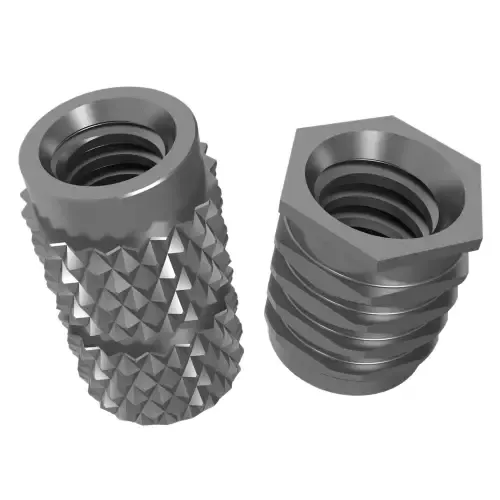
②. Self-Tapping Inserts
- Applicable materials: wood, soft plastics, some soft metals.
- Structural features: with self-tapping external threads, externally similar to wood screws or nails, with Phillips/hex drive slots in the head.
- Installation method: screwed in directly with electric screwdriver or hand tool without pre-tapping threads.
- Advantages:
- Quick installation, can be tapped directly into the base material;
- High resistance to pullout;
- Suitable for rear mounting and maintenance scenarios.
- Disadvantages: Higher requirements on installation angle, easy to be damaged due to eccentricity.
③. Heat-Set / Ultrasonic Inserts
- Applicable materials: Thermoplastics (e.g. ABS, PC, PP, etc.).
- Structural Characteristics: The shape is often with inverted teeth and groove structure, which is convenient for solid curing after melting into plastic.
- Installation method:
- Hot melt type: use soldering iron to heat the insert to make it melt into the plastic;
- Ultrasonic type: the use of high-frequency vibration will be inserted “into” the plastic.
- Advantages:
- Beautiful and neat installation;
- High bonding strength after curing;
- Suitable for automation and batch assembly.
- Disadvantages: Specialized equipment or temperature control tools are required, and the installation process requires some experience.
④. Molded-In Inserts
- Applicable materials: Injection molded parts (engineering plastics).
- Structural Characteristics: Pre-inserted into the mold at the time of injection molding and molded by the molten plastic overlay.
- Method of installation: Molded in one shot through an injection mold to become part of the plastic part.
- Advantages:
- Maximum strength, virtually impossible to pull out;
- Zero error in mounting;
- Low cost, suitable for mass production.
- Disadvantages:
- Can only be used for new mold design, not for post-installation;
- Mold accuracy and pre-embedded position requirements are extremely high.
⑤. Wire Thread Inserts / Helical Inserts
- Applicable Materials: Aluminum alloy, magnesium alloy and other metal parts.
- Structural features: Helical spring structure, inserted to form a standard internal threaded hole.
- Installation Method: Tapping the external thread first, then screwing in with installation tool;
- Advantages:
- Improved thread strength and wear resistance;
- Suitable for repairing slippery threaded screw holes;
- High load carrying capacity, suitable for high vibration applications.
- Disadvantages: more complicated installation, need special tools with tapping.
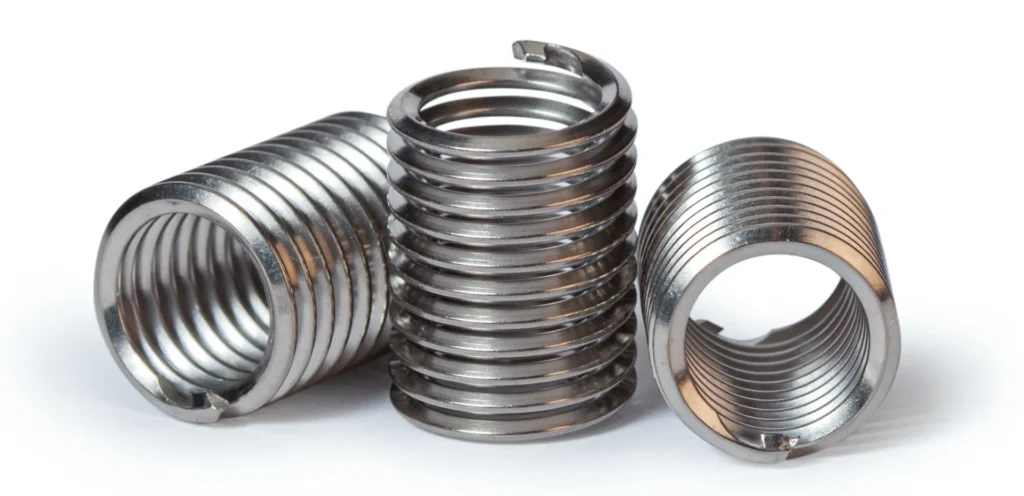
Summary Comparison Table:
| Type | Applicable Materials | Mounting | Strength Performance | Typical Applications |
|---|---|---|---|---|
| Press-In | Plastics, Soft Metals | Direct Press-In | Medium | Consumer Electronics, 3C Products |
| Spin-On | Wood, Plastic | Screw-In Mounting | High | Furniture, Plastic Shells |
| Thermal-Melt | Thermoplastic Plastics | Thermal-In/Ultrasonic | High | Plastic injection molded parts, automated assembly |
| In-Mold Embedding | Plastics (Injection Molding) | In-Mold Placement | Very High | Automotive Components, High Volume Injection Molding |
| Screw-in | Aluminum, Magnesium, and other Metals | Tapping + Mounting | Very High | Aerospace, Maintenance Work |
Where Are Threaded Inserts Used?
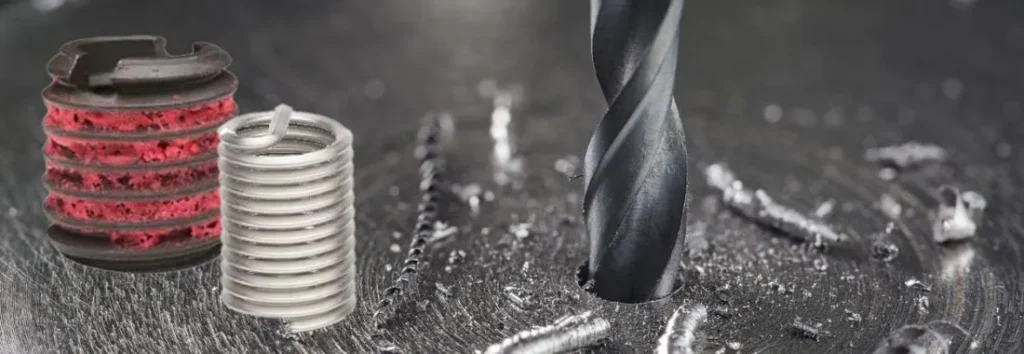
1. Press-In Inserts - for plastic housings and light-duty construction
- Consumer Electronics: provide durable screws for screw assembly in plastic structures such as laptop housings, remotes, and power adapters.
- Consumer Electronics: Provides durable threads for screw assembly in plastic structures such as laptop housings, remote controls, and power adapters.
- Small appliance assembly: such as vacuum cleaners, electric shavers and other products in the products, used to connect the cover plate, structural frame.
- Instrumentation housings: for ABS, PC and other material housings, with press-in inserts to enhance repeated tightening performance.
- Medical device components: When the requirements for neat appearance and removability are high, the use of press-in inserts can balance strength and reliability.
2. Self-Tapping Inserts - for wood and soft plastic joints
- Furniture Manufacturing: Commonly used for assembling solid wood, particle board, medium density board (MDF) and other furniture components, such as table leg fixing, connecting bolt holes etc.
- Audio equipment: used in wooden audio box connectors to enable them to withstand repeated assembly.
- Architectural Decorative Panel Installation: such as wood siding, decorative partitions of the pre-embedded screw holes.
- Soft Plastic Structural Parts: used in small batch plastic products that have lower mold costs but require repeated screw assembly.
3. Heat-Set / Ultrasonic Inserts - for injection-molded thermoplastic parts
- Automotive interior structural parts: such as dashboard bracket, interior cover plate and other high-temperature injection molded parts of the screw fixing bits.
- Power tool housings: such as electric drills, hot air guns and other plastic parts in the realization of a reliable connection.
- Industrial sensor housings: where high strength and sealing are required, reliable threaded connections are realized through hot melt inserts.
- 3D printed parts: suitable for use in PLA, ABS, PETG and other printing materials to enhance connection strength.
4. Molded-In Inserts (Molded-In Inserts) - for high-strength, batch-ready injection molding
- Automotive components: e.g., in one-shot structures such as seat skeletons and air conditioner housings.
- Electrical Junction Boxes: Bolt-on bits in plastic electrical boxes and junction boards, with a solid structure that is not easy to loosen.
- Aerospace interior parts: such as plastic hatch, seat plastic support structure, high strength connection parts that are not removable after installation.
- Intelligent Terminal Structural Parts: suitable for high-volume, standardized structural parts production, such as POS machine, ATM machine plastic shell connecting parts.
5. Wire Thread Inserts - for reinforcement and repair of metal base materials
- Aerospace Manufacturing: Used in aluminum and magnesium alloy structures to reinforce thread strength and prevent loosening of screw holes under high-frequency vibration.
- Machining Repair: Commonly used in the repair of slipped teeth and broken holes to avoid scrapping the whole part.
- Engine structural parts: such as cylinder block, shell on the high-strength bolt fixing points, through the screw sleeve to enhance the fatigue life.
- Military/rail equipment: thread life extension program in high demand occasions.
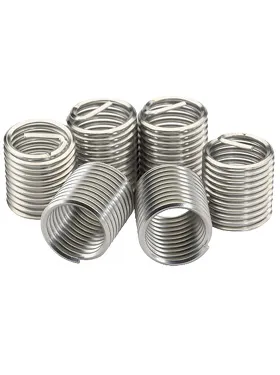
Summary Recommendations:
| Insert Type | Typical Application Scenarios | Recommended Master Material | Mounting |
|---|---|---|---|
| Press-In | Plastic Housings, Small Appliances, Medical Instruments | Plastics, Soft Metals | Direct Press-In |
| Spin-In | Furniture, Woodworking Components, Decorative Structures | Wood, Soft Plastics | Manual or Motorized Spin-In |
| Thermal Fusion/Ultrasonic | Injection Molded Plastic Components, Automotive Interiors, 3D Printing | Thermoplastics Plastics | Hot Melt or Ultrasonic Vibration |
| In-Mold Embedding | Automotive, Electrical & Electronics, Aerospace Injection Molded Structures | Plastics (injection molding required) | Pre-embedded during injection molding |
| Screw-in Bushings | Aerospace, Military, Metal Part Repair | Aluminum, Magnesium, and other metals | Tapping + Special Tools Screw-in |
I. Local Sourcing vs. Online Platforms
| Items | Local Sourcing | Online Platforms (Amazon, Alibaba, Website, etc.) |
|---|---|---|
| Delivery Cycle | Fast, same day/next day delivery | Alibaba/International Website mostly 7-30 days, Amazon is shorter |
| Product Choice | Limited, constrained by stock | |
| Technical support | Stronger, on-site communication, sample fitting | Weak, need to communicate via email/online |
| Minimum Order Quantity (MOQ) | Usually have certain MOQ requirements | Amazon supports retail, Alibaba supports bulk customization |
| Unit price | Medium to high, including service and shipping costs | Alibaba bulk Lower, Amazon retail usually higher |
| Traceability & Certification | Material report, inspection report available, more stable quality | Alibaba needs to take the initiative to verify the qualification, Amazon is mostly for consumer level products |
Recommendation:
- R&D stage or pilot production: use Amazon or local sourcing to quickly get samples for verification.
- Mass production: Prioritize factory direct supply on Alibaba or brand website to reduce unit price and ensure stable specification.
II. How to Judge the Reliability of a Seller/Brand
Brand seniority and industry reputation
- Whether it is a well-known brand in the industry (e.g. Keensert, Helicoil, AVK, Recoil, BAUMANN)
- Whether there are large OEM / Tier 1 manufacturers in Europe and the United States or domestic supporting experience
Product certification and technical data
- Whether to have ISO9001, IATF16949 and other quality system certification
- Whether to provide material certificate (MTC), RoHS, REACH, salt spray test report, etc.
Seller qualification
- Ali platform: whether the “Golden Products Enterprise”, factory certification, long years of transactions
- Amazon platform: check the buyer’s evaluation, pay attention to 1 star / 2 star content, avoid non-industrial use of the seller
- Official website: check whether there is a fixed contact person, customer service response efficiency, clarity of the contract terms
Sample consistency
- Whether the big goods are exactly the same as the sample (appearance, processing accuracy, surface treatment, etc.)
- Recommended before the first cooperation small batch trial order test assembly, drawing/torque performance
After-sales service
- Whether to provide quality problem return and exchange support
- Whether to support batch traceability and problem recovery process
Do You Have Any Questions?
Let Us Solve Your Problem
Choose Rivetfix for Threaded Inserts
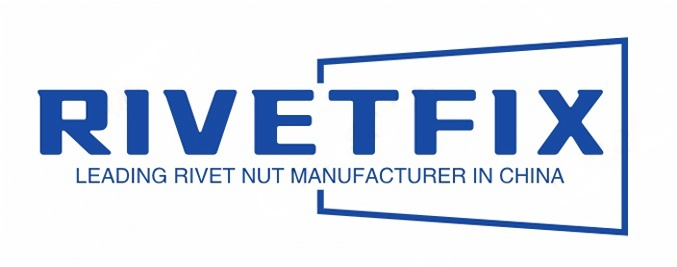
✅ Comprehensive range of products, suitable for a wide range of masterbatches
- Hot press inserts (for thermoplastics)
- Self-tapping inserts (for aluminum, plastic, wood)
- Locking nut (for metal parts repair enhancement)
- Heavy-duty threaded bushings (high pullout/shear requirements)
- Detachable threaded bushings (for repetitive assembly conditions)
Covering sizes from M2-M16 / UNC 2-56 to 5/8-11 and supporting surface treatments (zinc-plated, nickel-plated, stainless steel, etc.) and special corrosion-resistant/stripping-resistant structural designs.
- Non-standard structure development (e.g., shaped teeth, special slot, inner and outer teeth composite)
- Customers to drawings processing: 1-2 weeks to deliver the first piece of samples
- Multiple packaging methods: bulk, disk, strip for automated assembly use
✅ Global supply and technical support
- Warehouse centers in Asia-Pacific, North America, and Europe with 7-15 day delivery support
- Provide localized technical support and engineering validation services to help customers compress their development cycle by more than 30%.
- All products are compliant with RoHS/REACH environmental norms, and can provide PPAP/IMDS documentation package.
✅ Strict quality control and stable performance
- Each batch of products passes pulling force, torque value, dimensional consistency test
- Implementing 100% appearance and thread pass/stop gauge testing to ensure batch consistency
- Provide batch traceability QR code for production site management.
For specific project needs, sample requests or technical assistance, Rivetfix can provide quick selection advice, drawing support and sample validation.
Feel free to contact us for a technical data package and a quote for near-term delivery.
Get High Quality Rivet Nuts Quote!
Send Your Rivet Nut Request
For more than 20 years, Rivetfix has helped customers solve many rivet nuts sourcing needs and technical challenges.
Have a question? Contact us and we’ll provide you with the perfect solution.

